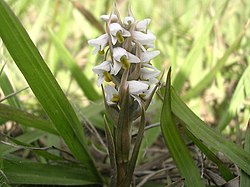| Zeuxine strateumatica | |
|---|---|
 | |
| Zeuxine strateumatica | |
| Scientific classification | |
| Kingdom: | Plantae |
| Clade: | Tracheophytes |
| Clade: | Angiosperms |
| Clade: | Monocots |
| Order: | Asparagales |
| Family: | Orchidaceae |
| Subfamily: | Orchidoideae |
| Tribe: | Cranichideae |
| Genus: | Zeuxine |
| Species: | Z. strateumatica |
| Binomial name | |
| Zeuxine strateumatica (Linnaeus) Schlechter | |
| Synonyms [1] [2] | |
| |
Zeuxine strateumatica, common names lawn orchid or soldier orchid, is a species of terrestrial orchids. It is widespread across much of Asia, including China, Japan, Turkey, Uzbekistan, Iran, the Indian subcontinent, Afghanistan, and Southeast Asia, as well as in New Guinea and in some of the islands of the Pacific. [1] It is naturalized in Saudi Arabia, Brazil, Tamaulipas (in northeastern Mexico), West Indies, Hawaii, California, and the southeastern United States from Texas to Georgia. [2] [3] [4] [5] [6]
Zeuxine strateumatica is a perennial herb up to 25 cm tall. Leaves are linear or narrowly lanceolate, up to 9 cm long. Flowers are borne in an erect panicle of as many as 50 flowers, each white with a yellow lip. [3]
In its natural habitat in Asia, Zeuxine strateumatica grows in grasslands, and along streambanks. [1] In places where it is introduced, it frequently grows in lawns and agricultural fields, and is thus considered a nuisance weed. [3]